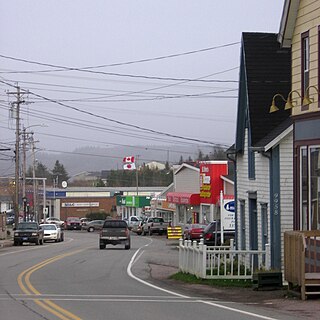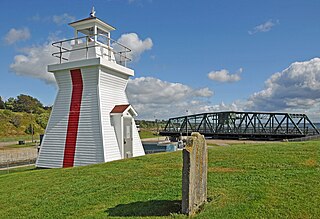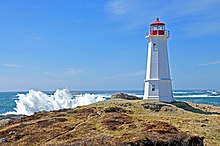
Cape Breton Island is a rugged and irregularly shaped island on the Atlantic coast of North America and part of the province of Nova Scotia, Canada.

The Fortress of Louisbourg is a tourist attraction as a National Historic Site and the location of a one-quarter partial reconstruction of an 18th-century French fortress at Louisbourg on Cape Breton Island, Nova Scotia. Its two sieges, especially that of 1758, were turning points in the Anglo-French struggle for what today is Canada.

Louisbourg is an unincorporated community and former town in Cape Breton Regional Municipality, Nova Scotia.

St. Peter's is a small incorporated village located on Cape Breton Island in Richmond County, Nova Scotia, Canada.

Cape Ray is a headland located at the southwestern extremity of the island of Newfoundland in the Canadian province of Newfoundland and Labrador.

A Pepperpot or Salt Shaker lighthouse is a type of small lighthouse that has an architectural style similar to a scaled up salt or pepper shaker. These lighthouses feature a square tapered base with a single gallery and a square lantern. They are usually shingled in wood and painted white; the lantern and trim are red. Many such lighthouses still exist across Canada, especially in the Maritime provinces.
George Island Light is a lighthouse located on George Island that lies in the middle of the North Basin of Lake Winnipeg in the Canadian province of Manitoba. It is located approximately 400 km (250 mi) north from Winnipeg, and approximately halfway between the shore communities of Grand Rapids and Poplar River.

Sambro Island Lighthouse is a landfall lighthouse located at the entrance to Halifax Harbour, Nova Scotia, on an island near the community of Sambro in the Halifax Regional Municipality. It is the oldest surviving lighthouse in North America and its construction is a National Historic Event.
The history of lighthouses in Canada dates to 1734.

Low Point Lighthouse is an historic Canadian lighthouse marking the eastern entrance to Sydney Harbour at New Victoria, Nova Scotia, near New Waterford, Nova Scotia. This is one of the earliest and most important light stations of Nova Scotia, one of the first dozen beacons in Nova Scotia to be lit to guide mariners, a classic red-and-white lighthouse still operated by the Canadian Coast Guard.

The Kidston Island Lighthouse is a lighthouse on Kidston Island, located in the Bras d'Or lakes, in Baddeck, Nova Scotia. The original lighthouse on Kidston Island was built in 1875. The present lighthouse was built in 1912 and the two stood side by side for some time. The lighthouse can only be accessed by boat; a ferry operates during the summer months.

The Devils Island Light is a Nova Scotia lighthouse located at the eastern shore entrance to Halifax Harbour on Devils Island, Nova Scotia. First lit in 1852, it was succeeded by a second lighthouse in 1877 which survives today. The lighthouse has influenced regional folklore and remains an important community landmark although it is currently neglected and threatened.

Cape Scott Lighthouse is at the northwestern extremity of Vancouver Island, British Columbia.

Point Riche Lighthouse, located in Port au Choix, Newfoundland in Canada's Newfoundland and Labrador province, is a "pepperpot" lighthouse that was built in 1892 and is still active. The white wooden tower is octagonal pyramidal in shape, the lantern room is painted red. The structure is 19 metres (62 ft) tall. Its light characteristic is a flash every 5 seconds, emitted at a focal plane height of 29 metres (95 ft). It is maintained by the Port au Choix National Historic Site.

Georges Island Lighthouse is a prominent concrete lighthouse, built in 1917 on Georges Island in Nova Scotia, replacing an earlier tower built in 1876. The light-keeper's house remains standing a few hundred feet to the north. The lighthouse is operated by the Canadian Coast Guard.

Cape d'Or is a headland located near Advocate, Cumberland County, on the Bay of Fundy coast of the Canadian province of Nova Scotia.

Balache Point Lighthouse also known as Balache Point Range Rear Lighthouse is an active Canadian lighthouse located next to the Canso Canal, near Port Hastings, Inverness County, Nova Scotia. The salt shaker style light, which sits on a small hillock on the Cape Breton side of the canal, is the second lighthouse to be built on the site.

Grandique Point Lighthouse is an aid to navigation for Lennox Passage, which is the channel of water between the southern shore of Cape Breton Island and Isle Madame, Nova Scotia, Canada. The lighthouse is located on the beach at Grandique Point in Lennox Passage Provincial Park and is accessible by a gravel road within the provincial park. The site is open to the public, the tower is closed.

The Louisbourg Lighthouse Trail is a hiking trail on Cape Breton Island in the Canadian province of Nova Scotia. The trailhead is located on Lighthouse Point, at the Louisbourg Lighthouse, within the Fortress of Louisbourg National Historic Site. The Louisbourg Lighthouse is the site of Canada’s first lighthouse which was built here in 1734.

















